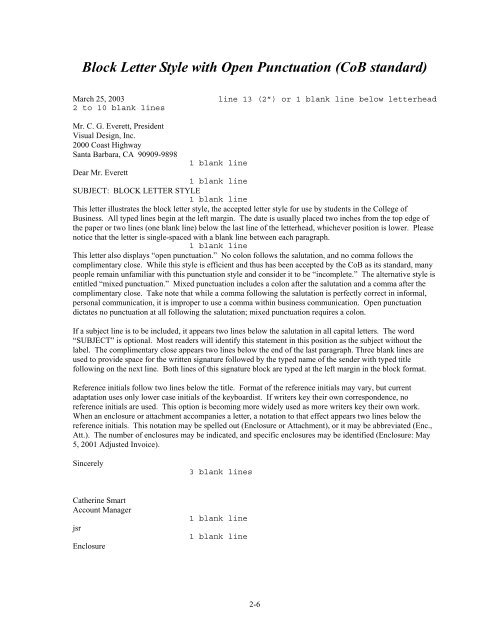Ohio University College of Business Communication Standards
Ohio University College of Business Communication Standards
Ohio University College of Business Communication Standards
Create successful ePaper yourself
Turn your PDF publications into a flip-book with our unique Google optimized e-Paper software.
Block Letter Style with Open Punctuation (CoB standard)<br />
March 25, 2003 line 13 (2”) or 1 blank line below letterhead<br />
2 to 10 blank lines<br />
Mr. C. G. Everett, President<br />
Visual Design, Inc.<br />
2000 Coast Highway<br />
Santa Barbara, CA 90909-9898<br />
1 blank line<br />
Dear Mr. Everett<br />
1 blank line<br />
SUBJECT: BLOCK LETTER STYLE<br />
1 blank line<br />
This letter illustrates the block letter style, the accepted letter style for use by students in the <strong>College</strong> <strong>of</strong><br />
<strong>Business</strong>. All typed lines begin at the left margin. The date is usually placed two inches from the top edge <strong>of</strong><br />
the paper or two lines (one blank line) below the last line <strong>of</strong> the letterhead, whichever position is lower. Please<br />
notice that the letter is single-spaced with a blank line between each paragraph.<br />
1 blank line<br />
This letter also displays “open punctuation.” No colon follows the salutation, and no comma follows the<br />
complimentary close. While this style is efficient and thus has been accepted by the CoB as its standard, many<br />
people remain unfamiliar with this punctuation style and consider it to be “incomplete.” The alternative style is<br />
entitled “mixed punctuation.” Mixed punctuation includes a colon after the salutation and a comma after the<br />
complimentary close. Take note that while a comma following the salutation is perfectly correct in informal,<br />
personal communication, it is improper to use a comma within business communication. Open punctuation<br />
dictates no punctuation at all following the salutation; mixed punctuation requires a colon.<br />
If a subject line is to be included, it appears two lines below the salutation in all capital letters. The word<br />
“SUBJECT” is optional. Most readers will identify this statement in this position as the subject without the<br />
label. The complimentary close appears two lines below the end <strong>of</strong> the last paragraph. Three blank lines are<br />
used to provide space for the written signature followed by the typed name <strong>of</strong> the sender with typed title<br />
following on the next line. Both lines <strong>of</strong> this signature block are typed at the left margin in the block format.<br />
Reference initials follow two lines below the title. Format <strong>of</strong> the reference initials may vary, but current<br />
adaptation uses only lower case initials <strong>of</strong> the keyboardist. If writers key their own correspondence, no<br />
reference initials are used. This option is becoming more widely used as more writers key their own work.<br />
When an enclosure or attachment accompanies a letter, a notation to that effect appears two lines below the<br />
reference initials. This notation may be spelled out (Enclosure or Attachment), or it may be abbreviated (Enc.,<br />
Att.). The number <strong>of</strong> enclosures may be indicated, and specific enclosures may be identified (Enclosure: May<br />
5, 2001 Adjusted Invoice).<br />
Sincerely<br />
Catherine Smart<br />
Account Manager<br />
jsr<br />
Enclosure<br />
3 blank lines<br />
1 blank line<br />
1 blank line<br />
2-6




